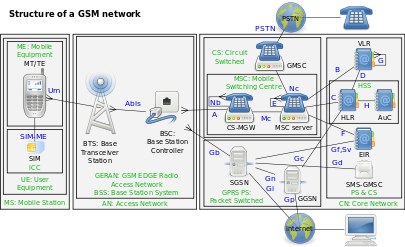GSM is a cellular network, which means that mobile phones connect to it by searching for cells in the immediate vicinity. There are five different cell sizes in a GSM network—macro, micro, pico,femto and umbrella cells. The coverage area of each cell varies according to the implementation environment. Macro cells can be regarded as cells where the base station antenna is installed on a mast or a building above average roof top level. Micro cells are cells whose antenna height is under average roof top level; they are typically used in urban areas. Picocells are small cells whose coverage diameter is a few dozen metres; they are mainly used indoors. Femtocells are cells designed for use in residential or small business environments and connect to the service provider’s network via a broadband internet connection. Umbrella cells are used to cover shadowed regions of smaller cells and fill in gaps in coverage between those cells.
The modulation used in GSM is Gaussian minimum-shift keying (GMSK), a kind of continuous-phase frequency shift keying. In GMSK, the signal to be modulated onto the carrier is first smoothed with a Gaussian low-pass filter prior to being fed to a frequency modulator, which greatly reduces the interference to neighboring channels (adjacent-channel interference).

The modulation used in GSM is Gaussian minimum-shift keying (GMSK), a kind of continuous-phase frequency shift keying. In GMSK, the signal to be modulated onto the carrier is first smoothed with a Gaussian low-pass filter prior to being fed to a frequency modulator, which greatly reduces the interference to neighboring channels (adjacent-channel interference).
Network structure
The network is structured into a number of discrete sections:
- The Base Station Subsystem (the base stations and their controllers).
- the Network and Switching Subsystem (the part of the network most similar to a fixed network). This is sometimes also just called the core network.
- The GPRS Core Network (the optional part which allows packet based Internet connections).
- The Operations support system (OSS) for maintenance of the network.
Flow Diagram


what is IAM,ACM,ANM,REL,RLC here sir
ReplyDeletewhat is IAM,ACM,ANM,REL,RLC here in CRBT
ReplyDeleteThanks for sharing information. long range wifi antenna & rfid antenna manufacturers
ReplyDeleteWe are a UK leased line provider with a price promise guarantee. We also offer you an instant leased line quote on our website.
ReplyDeleteleased line costs